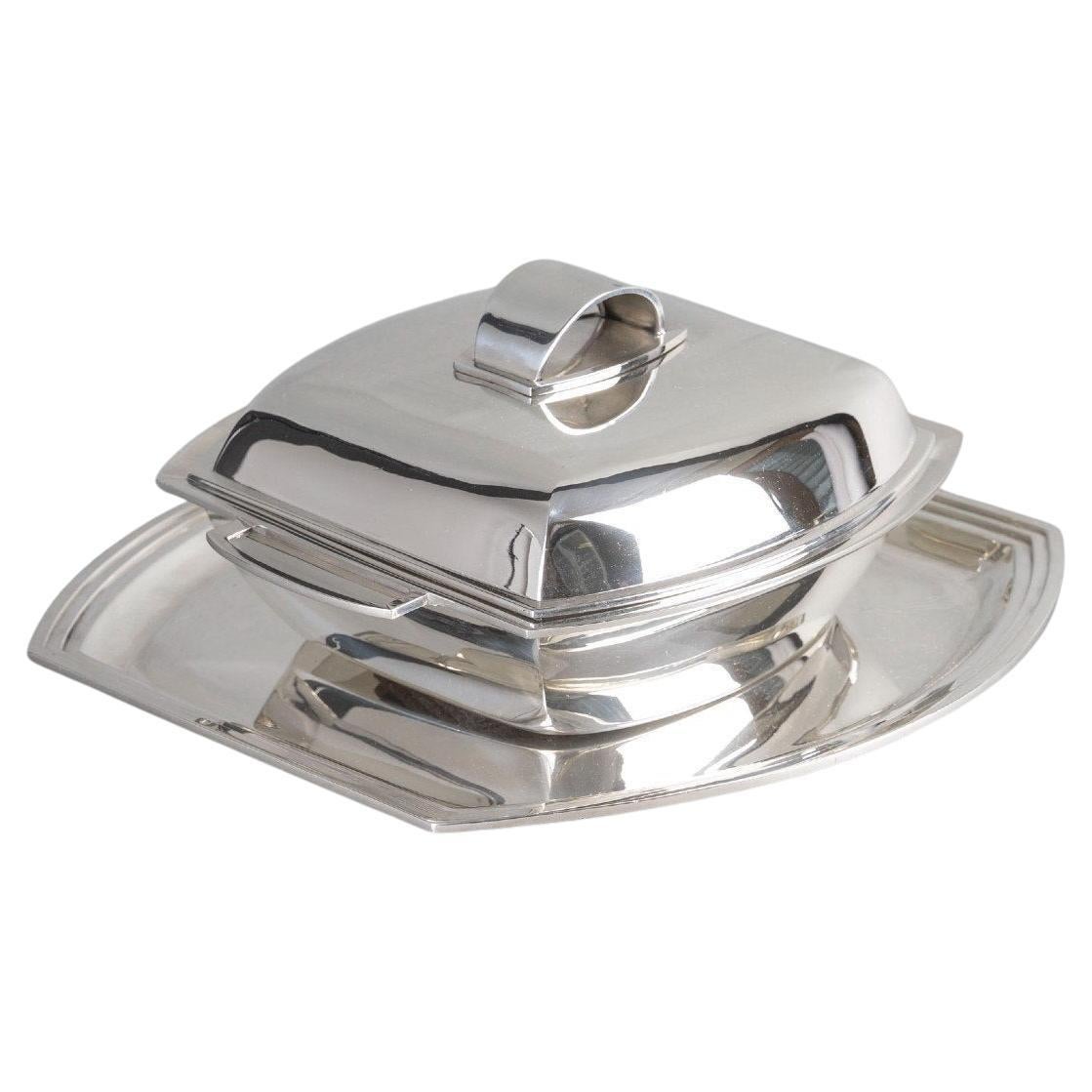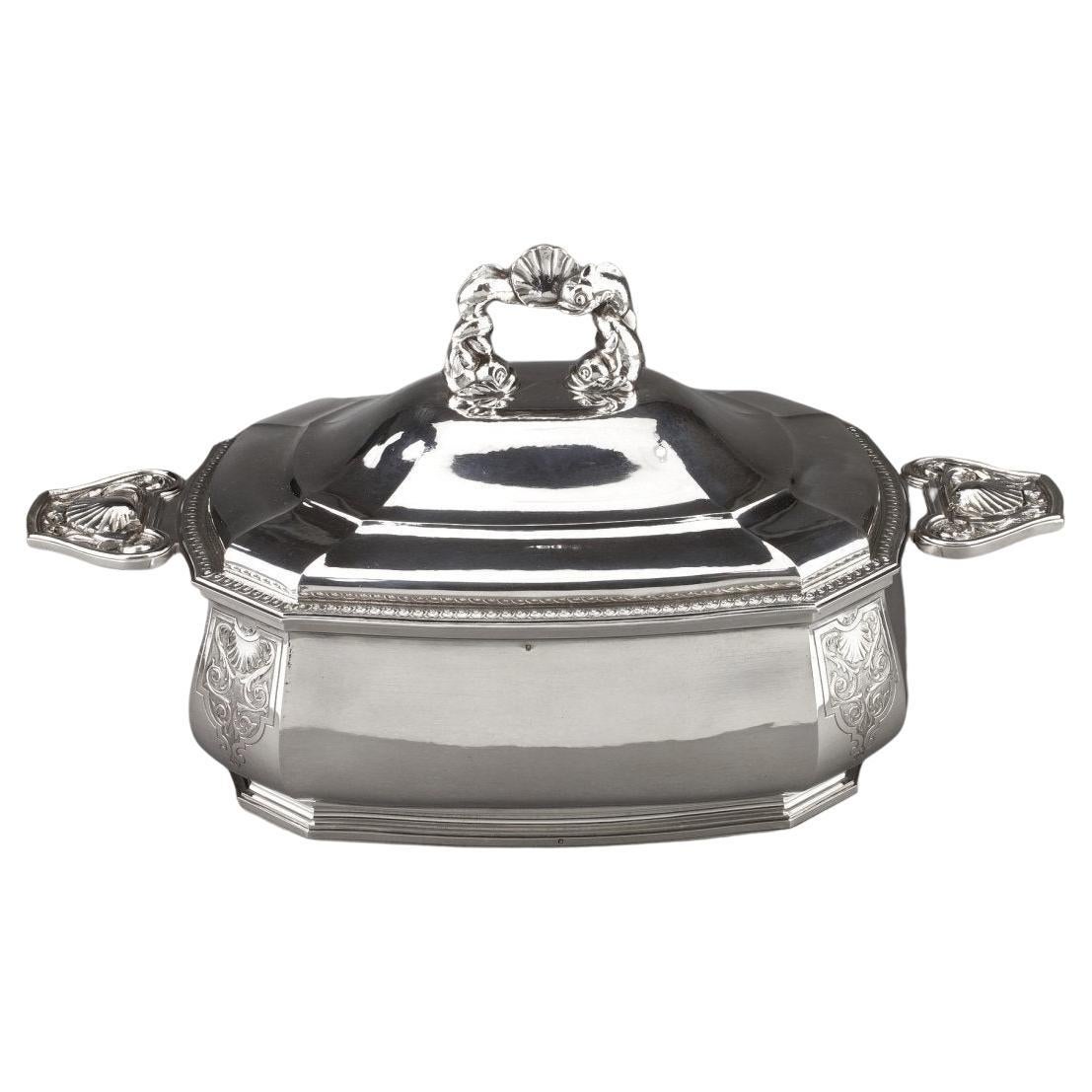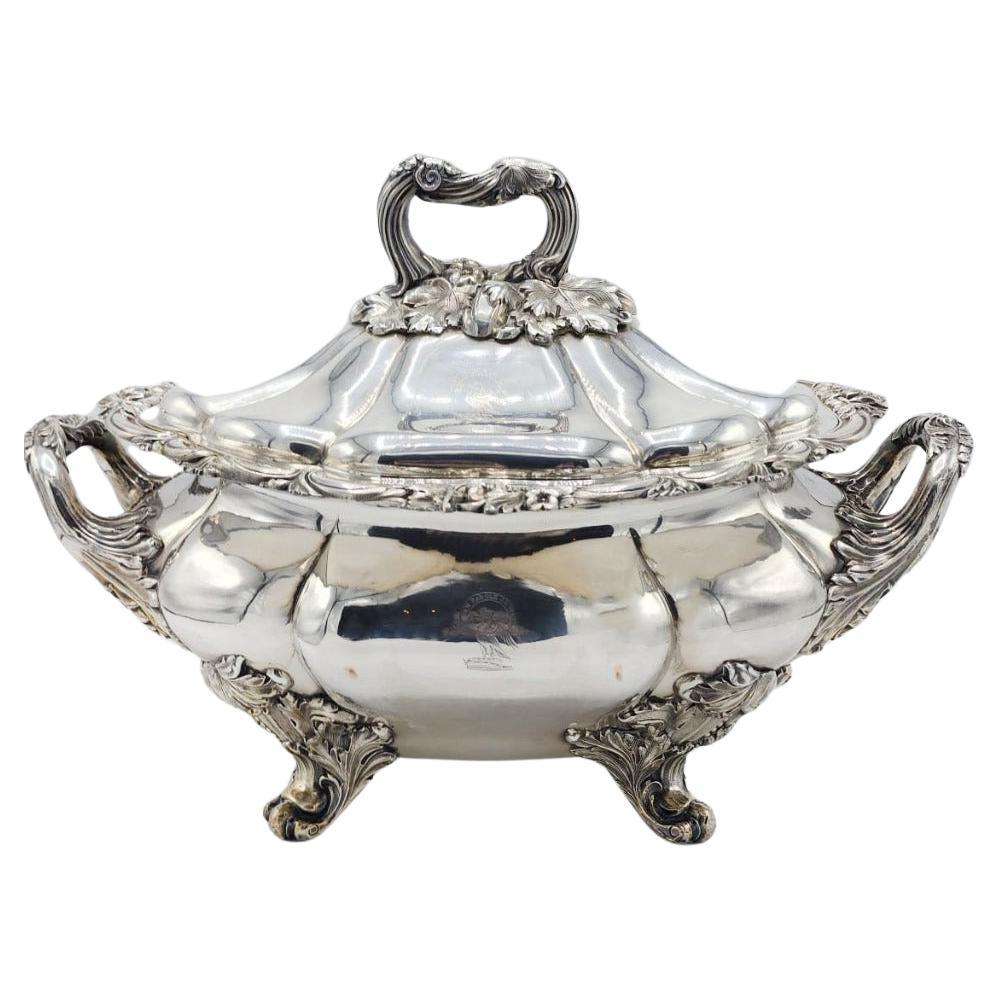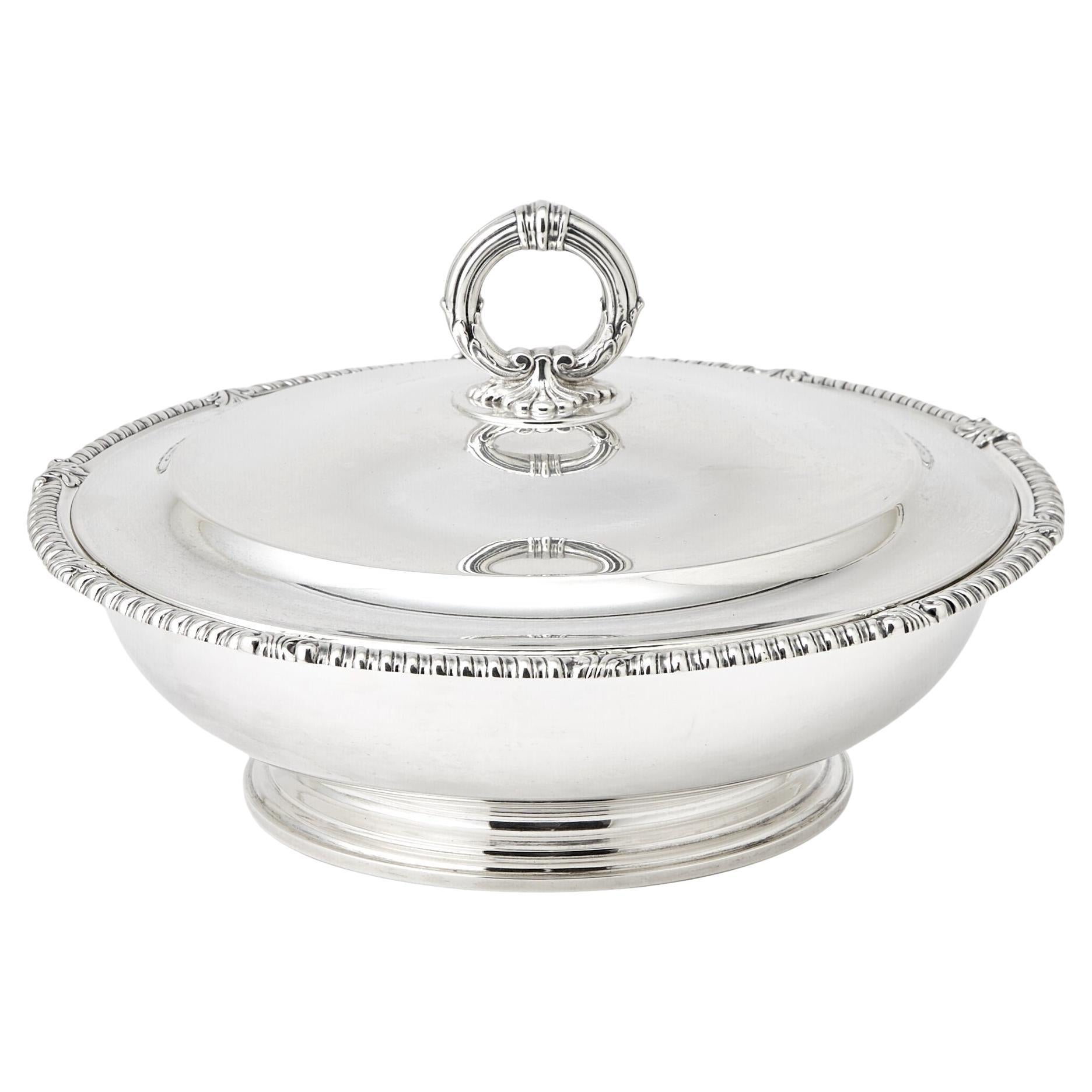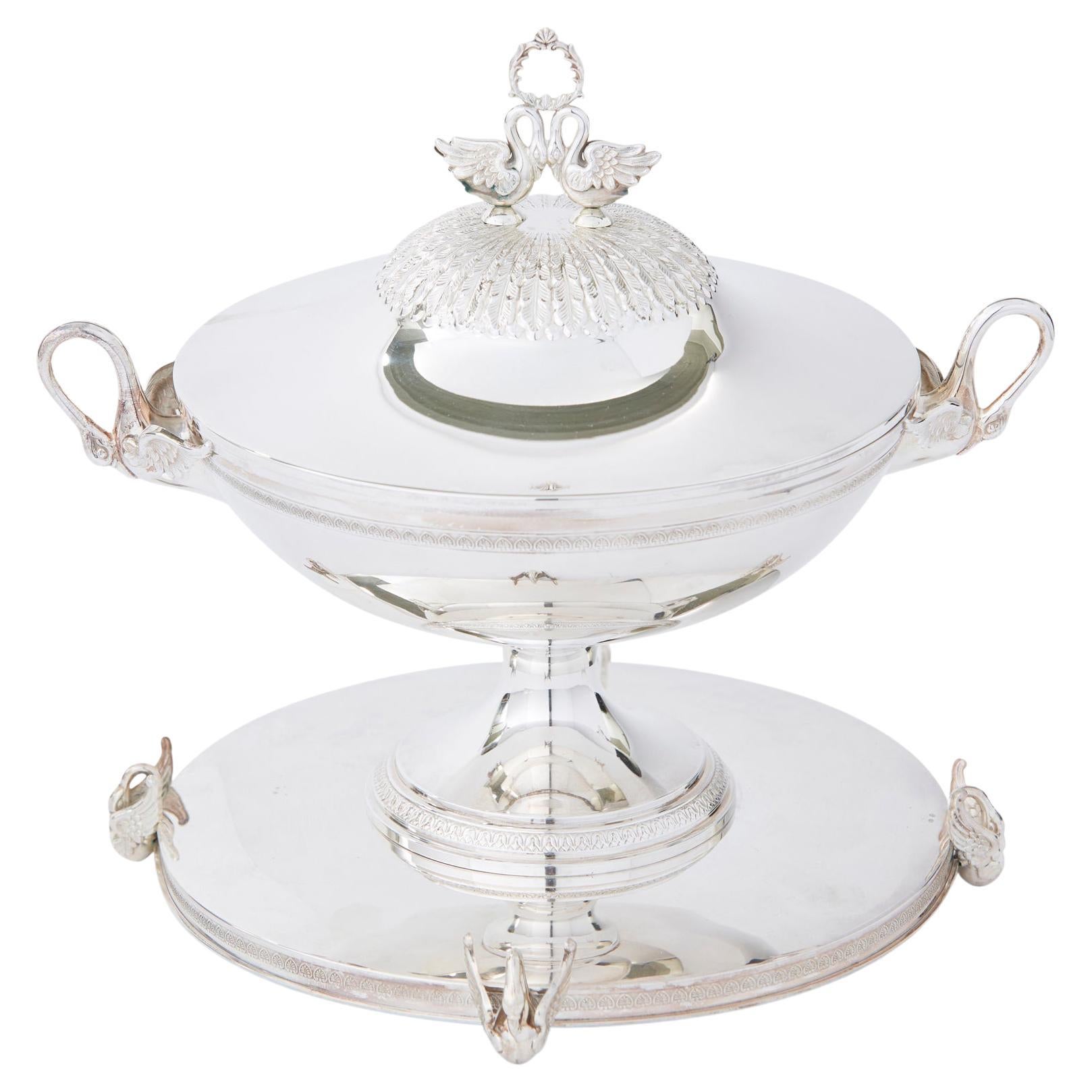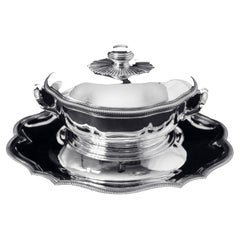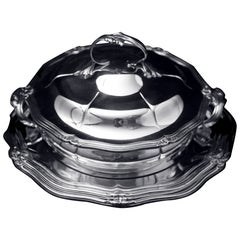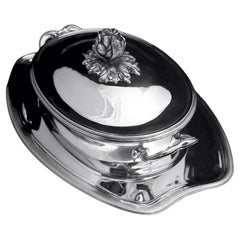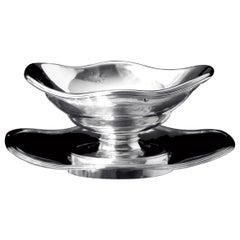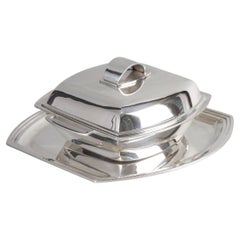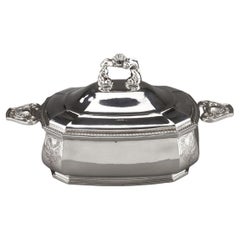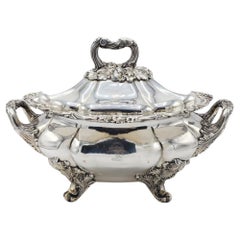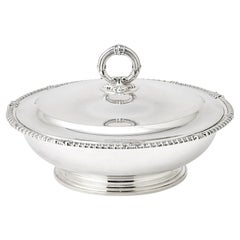Items Similar to Gruhier - Original French Art Deco 950 Sterling Silver Serving Tureen
Want more images or videos?
Request additional images or videos from the seller
1 of 7
Gruhier - Original French Art Deco 950 Sterling Silver Serving Tureen
$20,277per set
£15,393.95per set
€17,607.40per set
CA$28,329.91per set
A$31,509.04per set
CHF 16,453.04per set
MX$383,431.54per set
NOK 210,130.47per set
SEK 197,065.31per set
DKK 131,410.76per set
Shipping
Retrieving quote...The 1stDibs Promise:
Authenticity Guarantee,
Money-Back Guarantee,
24-Hour Cancellation
About the Item
Direct from Paris the Birthplace of Art Deco, a Stunning "Gatsby Era" Original French 950 Sterling Silver Art Deco Tureen by Internationally Known French Silversmith "J. Gruhier" Sophisticated Luxury at a Very Affordable Price, You Can't Go Wrong Buying Quality, circa early 1900s. The name Gruhier, although perhaps not as universally recognized as some of its contemporaries, represents an illustrious chapter in the annals of French silver-smithing. Emerging during a vibrant period of artistic innovation, Gruhier became synonymous with exceptional quality and craftsmanship.
Founded in the late 19th century, Gruhier’s workshop quickly established itself as a beacon of excellence in the French silver industry. The founder, whose meticulous attention to detail and profound understanding of metallurgical processes set the stage for the firm's legacy, imbued his creations with a level of craftsmanship that rivaled the era's most esteemed silversmiths. Gruhier’s ascent to prominence was marked by a dedication to craftsmanship and aesthetic excellence. The firm’s early work, primarily influenced by late Victorian styles, gradually evolved, embracing the modernist waves sweeping across Europe. By the 1920s, Gruhier had adeptly transitioned to the Art Deco style, which became a defining feature of its identity.
Art Deco, characterized by its bold geometric forms and lavish ornamentation, was a perfect match for Gruhier's meticulous craftsmanship. The silversmiths at Gruhier excelled in integrating symmetry and simplicity with luxurious materials, creating pieces that were both modern and timeless. Their use of streamlined shapes and incorporation of exotic motifs and materials reflected the era's fascination with innovation and luxury. Gruhier was renowned for its advanced techniques in silver manipulation, including precision casting and intricate chasing. The firm also pioneered the integration of other luxurious materials such as ivory and enamel, which accentuated the opulence of their silver creations. These innovations not only set new standards in silver-smithing but also aligned perfectly with the Art Deco ethos of combining art with functionality.
The excellence of Gruhier’s craftsmanship was recognized and celebrated at numerous international exhibitions. Notably, their Art Deco pieces received high acclaim at the Exposition Internationale des Arts Décoratifs et Industriels Modernes in 1925 in Paris, which indeed was the event that gave the Art Deco movement its name. The recognition at such a prestigious venue solidified Gruhier's reputation as a leader in the Art Deco style.
Throughout its history, Gruhier received numerous awards, including several gold medals in national and international crafts competitions. These accolades not only celebrated the firm's artistic achievements but also highlighted their technical prowess and innovative approach to silver-smithing. The allure of Gruhier’s silverware extended to the highest echelons of society, including various European royal families. Their bespoke creations for these patrons were often customized to suit the lavish and sophisticated settings of royal residences, featuring personalized emblems and family crests. Gruhier’s ability to cater to such distinguished clientele reinforced its status as a purveyor of luxury. The royal patronage also provided a platform for the firm to showcase the breadth of its artistry and the versatility of its designs, which were both elegant and highly functional.
Among Gruhier’s most celebrated contributions to the Art Deco period were their sterling silver serving tureens and vegetable servers. These items stood out for their bold aesthetic that broke away from earlier, more ornate designs prevalent in silver items. Their sleek lines, geometric patterns, and the judicious use of color contrast embodied the modern spirit of the 1920s and 1930s. The serving tableware designed by Gruhier during the Art Deco period have become emblematic of the era. Collectors and museums continue to prize these items for their beauty and historical significance. The enduring appeal of these pieces attests to Gruhier's mastery of design and their pivotal role in the development of modern silver-smithing.
Gruhier’s journey through the transformative years of the Art Deco movement highlights a legacy characterized by artistic innovation and exquisite craftsmanship. The firm’s dedication to excellence in the creation of sterling silver tureens and tableware not only defined an era of luxury but also set standards that continue to influence the world of silversmithing. The enduring legacy of Gruhier, marked by prestigious awards, royal patronage, and iconic designs, remains a testament to their standing in the pantheon of great French silversmiths. Through their remarkable creations, Gruhier has left an indelible mark on the decorative arts, symbolizing the fusion of artistic vision and impeccable craftsmanship that continues to inspire and captivate connoisseurs around the globe.
This magnificent covered 950 sterling silver art deco serving tureen and presentation platter are a stunning example of the quality and craftsmanship for which Gruhier was internationally known. Together they stand approximately 20.50cm. high to the top of the lid and weigh 3,714 grams. Each piece is stamped with the French Government's Head of the Minerva 1 Hallmark certifying a minimum of 950 sterling silver as well as the "J. Gruhier" sterling silver manufacturer's hallmark. J. Gruhier & Sons operated at 14 Rue de la Cordene here in Paris from 1897. The tureen itself measures approximately 32cm. in length to the tips of the handles, 19cm. wide at its widest point and weights 2,162 grams. It is stamped with the French Government's Head of the Minerva 1 Hallmark certifying a minimum of 950 sterling silver as well as the "J.Gruhier" sterling silver manufacturer's hallmark. The tureen's custom presentation platter measures approximately 41cm. in length, 30cm. wide at its widest point and weights 1,552 grams. It is also stamped with the French Government's Head of the Minerva 1 Hallmark certifying a minimum of 950 sterling silver as well as the "J.Gruhier" sterling silver manufacturer's hallmark. You can’t go wrong buying quality.
- Creator:J. Gruhier (Manufacturer)
- Sold As:Set of 3
- Style:Art Deco (Of the Period)
- Materials and Techniques:
- Place of Origin:
- Period:
- Date of Manufacture:1920s
- Condition:Refinished. Each of the pieces has been professionally refinished to near new condition.
- Seller Location:Wilmington, DE
- Reference Number:1stDibs: LU9583239465112
About the Seller
No Reviews Yet
Vetted Professional Seller
Every seller passes strict standards for authenticity and reliability
1stDibs seller since 2023
6 sales on 1stDibs
- ShippingRetrieving quote...Shipping from: Paris, France
- Return Policy
Authenticity Guarantee
In the unlikely event there’s an issue with an item’s authenticity, contact us within 1 year for a full refund. DetailsMoney-Back Guarantee
If your item is not as described, is damaged in transit, or does not arrive, contact us within 7 days for a full refund. Details24-Hour Cancellation
You have a 24-hour grace period in which to reconsider your purchase, with no questions asked.Vetted Professional Sellers
Our world-class sellers must adhere to strict standards for service and quality, maintaining the integrity of our listings.Price-Match Guarantee
If you find that a seller listed the same item for a lower price elsewhere, we’ll match it.Trusted Global Delivery
Our best-in-class carrier network provides specialized shipping options worldwide, including custom delivery.More From This Seller
View AllPuiforcat (Hermes) - 4pc. Antique French 950 Sterling Silver Covered Tureen
By Puiforcat
Located in Wilmington, DE
Direct from Paris, a Stunning Large 4pc. Covered Louis XVI, Antique 950 Sterling Silver Vegetable Server with Presentation Platter by the World's Premier French Silversmith - Emile P...
Category
Early 20th Century French Louis XVI Sterling Silver
Materials
Sterling Silver
$20,468 / set
Free Shipping
Odiot - 5pc. Antique French Sterling Silver Table Serving Set, Like New !
By Odiot
Located in Wilmington, DE
Direct from Paris, a stunning sterling silver table serving set of 2 magnificent round serving platters and 1 covered vegetable server with sterling interior by one of the world’s pr...
Category
Antique Late 19th Century French Louis XVI Sterling Silver
Materials
Sterling Silver
Puiforcat (Hermes) - 3pc. Louis XVI French 950 Sterling Silver Covered Server
By Puiforcat
Located in Wilmington, DE
Direct from a private residence in Monaco, a stunning 19th century, Louis XVI covered sterling silver vegetable server by the world’s premier French silversmith “Puiforcat”, currentl...
Category
Antique Late 19th Century French Louis XVI Sterling Silver
Materials
Sterling Silver
$15,811 / set
Free Shipping
Odiot - 4pc. 19th Century 950 Sterling Silver Louis XVI Gravy Boat, Noble Crest
By Odiot
Located in Wilmington, DE
Direct from Paris, A Magnificent 4 pc. 19th Century 950 Sterling Silver Louis XVI Gravy Boat with Presentation Platter and Two Sterling Silver Inserts and Noble Crest by the World's Premier French Silversmith Jean-Baptiste Odiot, Absolutely Stunning - circa late 1800s. Jean-Baptiste Claude Odiot, an illustrious French silversmith, significantly influenced the decorative arts in Europe during the late 18th and early 19th centuries. His remarkable craftsmanship, innovative designs, and the opulence of his creations earned him an esteemed place amongst the royal and aristocratic patrons of his time.
Born in 1763 in Paris, Jean-Baptiste Claude Odiot was destined to be a silversmith, a craft that ran in his family. He apprenticed under his grandfather, Jean-Baptiste Gaspard Odiot, and later under the renowned silversmith Jean-Baptiste-Claude Roettiers. This training period was crucial as it grounded him in the traditional techniques of the trade while also exposing him to the evolving tastes of the French aristocracy, preparing him for a successful career.
Odiot's work was marked by meticulous attention to detail and a robust embrace of the neoclassical style, which became prevalent in the late 18th century. His ability to blend artistic beauty with functional design set his pieces apart. Odiot introduced a range of innovative techniques in silverwork, including his use of the repoussé method to create intricate raised patterns, and chasing, to refine and detail these designs. His mastery over silver casting and gilding also allowed him to produce pieces with exceptional quality and durability, making them highly prized collectibles.
The prestige of Jean-Baptiste Odiot was significantly enhanced by his association with European royalty. His rise to fame coincided with the period of Napoleon Bonaparte, who was an avid patron of the arts. Odiot received substantial commissions from the imperial family, including a famous 179-piece dinner service for Napoleon’s wedding to Marie-Louise of Austria in 1810. This patronage not only secured Odiot's financial success but also established his reputation as a purveyor of luxury goods suitable for the highest echelons of society.
Recognition of Odiot's talent came not only from his royal and aristocratic patrons but also from various artistic institutions. He was awarded the Legion of Honour by Napoleon, a testament to his influence and status in the arts. Moreover, Odiot's participation in exhibitions, such as the Exposition des Produits de l'Industrie Française, garnered him critical acclaim, enhancing his stature and legacy in the decorative arts. Among Odiot's diverse oeuvre, his sterling silver gravy servers...
Category
Antique Late 19th Century French Louis XVI Sterling Silver
Materials
Sterling Silver
$7,437 / set
Free Shipping
Puiforcat (Hermes) - 2pc. Louis XVI Sterling Silver Vegetable Server - MINT !
By Puiforcat
Located in Wilmington, DE
Direct from a private residence in Paris, a magnificent 19th century, Louis XVI covered sterling silver tureen by the world's premier French silversmith "Puiforcat", currently owned by Hermes, a beautifully elegant set - Circa 1890s, MAGNIFICENT. The art of silver-smithing has been a distinguished part of French heritage for centuries, producing some of the most exquisite and sought-after silverware in the world. Among the names synonymous with excellence in this field, Puiforcat stands out for its unparalleled craftsmanship, rich history, royal patronage, and innovative designs.
Puiforcat's story began in 1820 when Jean-Baptiste Fuchs, a skilled silversmith, established a workshop in Paris. This workshop laid the foundation for what would become one of the most prestigious names in silver-smithing. In 1857, Louis-Victor Puiforcat, Fuchs' son-in-law, joined the business, bringing with him a passion for the craft that would define the company’s future. The business was subsequently renamed "Puiforcat" and began to flourish, gaining a reputation for its exceptional silverware. Throughout the 19th and early 20th centuries, Puiforcat expanded its range of products, producing not only silver flatware but also intricate tableware, decorative pieces, and objets d'art. The company's commitment to quality and innovation was evident in their designs, which often incorporated elements of Art Deco, a style that became closely associated with Puiforcat during the early 20th century. This period also saw the involvement of Jean Puiforcat, a visionary designer who played a crucial role in establishing the brand's modern identity.
Puiforcat's silver pieces are renowned for their exceptional quality and craftsmanship. Each piece is meticulously crafted by skilled artisans who adhere to traditional techniques passed down through generations. The process of creating Puiforcat silver pieces involves multiple stages, including design, forging, chasing, and polishing, each requiring a high level of expertise and precision. One of the hallmarks of Puiforcat silverware...
Category
Antique Late 19th Century French Louis XVI Sterling Silver
Materials
Sterling Silver
$9,296 / set
Free Shipping
Henin - 2pc. Louis XVI Covered 950 Sterling Silver Vegetable Server - MINT !
By Henin et Cie 1
Located in Wilmington, DE
Direct from a private chateau in France, a stunning, privately commissioned, 2-piece, Louis XVI antique French 950 covered sterling silver vegetable server (tureen) by internationall...
Category
Antique Late 19th Century Louis XVI Sterling Silver
Materials
Sterling Silver
$8,860 / set
Free Shipping
You May Also Like
Christofle - Modernist Tureen On Its Art Deco Sterling Silver Tray
Located in SAINT-OUEN-SUR-SEINE, FR
Centerpiece formed by a covered tureen on its tray, rectangular in shape with a flat bottom and flanked by two side handles, the ogee lid is topped with a semi-circular grip.
The tur...
Category
Early 20th Century French Centerpieces
Materials
Sterling Silver
Goldsmith Bancelin - Soup Tureen In Sterling Silver Around 1950/1960
Located in SAINT-OUEN-SUR-SEINE, FR
Centerpiece represented by a solid silver octagonal tureen. the domed body is engraved on four sides with a decoration of foliage and shell arabesques, flanked on each side by chisel...
Category
Mid-20th Century French Mid-Century Modern Sterling Silver
Materials
Sterling Silver
English Sheffield silver tureen, Le parole Je vis - 19th Century
Located in Autonomous City Buenos Aires, CABA
English Sheffield silver tureen, Le parole Je vis - 19th Century
English tureen covered in silver, reproduction of the Old Sheffield model, with representation of flower and harves...
Category
Antique 19th Century English Art Nouveau Sheffield and Silverplate
Materials
Silver
Mid-20th Century Tiffany & Co. Sterling Silver Art Deco Covered Tureen
By Tiffany & Co.
Located in Tarry Town, NY
A stunning mid-20th century sterling silver covered tureen by the renowned Tiffany & Co., showcasing the timeless elegance of Art Deco design. This exquisite piece features a classic...
Category
Mid-20th Century Mid-Century Modern Sterling Silver
Materials
Sterling Silver
Antique Silver Plated Entrée Serving Dish Tureen Covered Sheffield English & Lid
Located in Wembley, GB
Antique Early 20th Century English Silver Plated Lidded Entree Serving Dish
Condition: All aspects are sound and secure and there are no dings, dents, bends or pitting. There is som...
Category
Antique Early 1900s British Art Deco Platters and Serveware
Materials
Silver, Silver Plate, Sterling Silver
$285 Sale Price / item
20% Off
Free Shipping
20th Century Silver Plated Covered Tureen
Located in Tarry Town, NY
Mid 20th century silver plated tableware centerpiece / serverware covered tureen with underplate holding base and exterior swans design details top & ha...
Category
Mid-20th Century European Soup Tureens
Materials
Silver Plate
More Ways To Browse
Chase Deco
Art Deco Chase
Silver Platform
Art Deco Black Geometric Glass
Arts And Craft Server
Gatsby Furniture
Ivory Handle Sterling
International Vision Sterling
Sterling Silver Covered Vegetable
Wave Crest Glass
Pantheon Sterling
Wave Crest Antique Glass
Treasure Sterling Flatware
Victorian Scent Bottles
Antique Glass Cutter
Antique Silver Butter Dish
Antique Silver Cake Knife
Antique Wash Bowl Set
